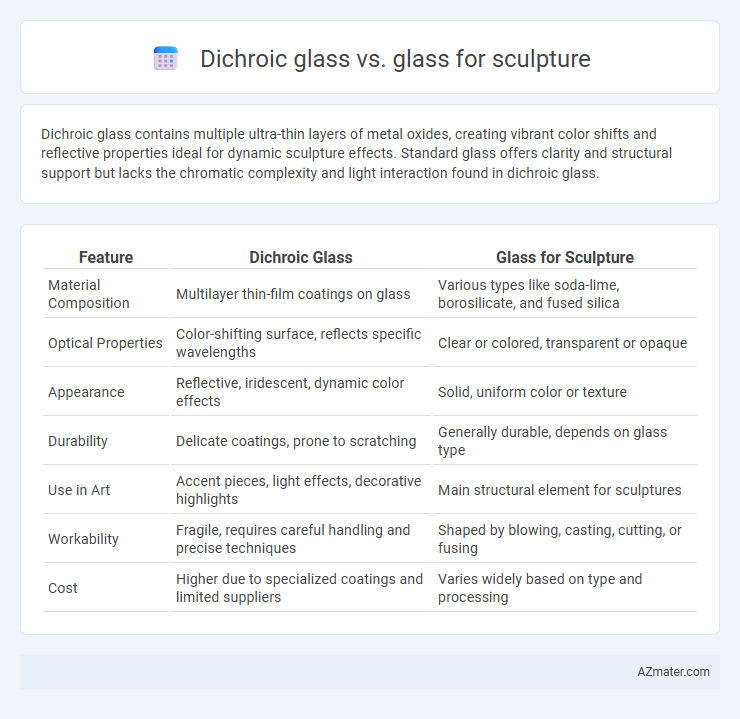Dichroic glass contains multiple ultra-thin layers of metal oxides, creating vibrant color shifts and reflective properties ideal for dynamic sculpture effects. Standard glass offers clarity and structural support but lacks the chromatic complexity and light interaction found in dichroic glass.
Table of Comparison
| Feature | Dichroic Glass | Glass for Sculpture |
|---|---|---|
| Material Composition | Multilayer thin-film coatings on glass | Various types like soda-lime, borosilicate, and fused silica |
| Optical Properties | Color-shifting surface, reflects specific wavelengths | Clear or colored, transparent or opaque |
| Appearance | Reflective, iridescent, dynamic color effects | Solid, uniform color or texture |
| Durability | Delicate coatings, prone to scratching | Generally durable, depends on glass type |
| Use in Art | Accent pieces, light effects, decorative highlights | Main structural element for sculptures |
| Workability | Fragile, requires careful handling and precise techniques | Shaped by blowing, casting, cutting, or fusing |
| Cost | Higher due to specialized coatings and limited suppliers | Varies widely based on type and processing |
Introduction to Glass Art in Sculpture
Dichroic glass, characterized by its multi-layered optical coating, offers vibrant color shifts and reflective properties that enhance the visual depth of sculptures compared to traditional glass. Traditional glass provides clarity and structural form but lacks the dynamic light interplay found in dichroic variants, making it less visually complex. Artists choosing dichroic glass for sculpture benefit from its ability to change appearance based on lighting and viewing angles, creating engaging, multidimensional art pieces.
What is Dichroic Glass?
Dichroic glass is a unique material known for its multi-layered coating that reflects and transmits specific wavelengths of light, creating vibrant color shifts depending on the viewing angle. This specialized glass is composed of ultra-thin layers of metal oxides deposited on the surface, resulting in a prismatic effect ideal for dynamic sculptures. Unlike traditional glass used in sculpture, dichroic glass offers enhanced optical properties that add vivid color and depth, making it a popular choice for artists seeking visually striking installations.
Traditional Glass Types Used in Sculpture
Traditional glass types used in sculpture include soda-lime glass, known for its affordability and ease of shaping, and borosilicate glass, valued for its thermal resistance and durability. In comparison, dichroic glass incorporates multiple micro-layers of metal oxides, creating a reflective and color-shifting effect that enhances visual complexity but is generally more expensive and delicate. Sculptors choose traditional glass for structural strength and versatility, while dichroic glass is favored for its vibrant, iridescent aesthetic qualities.
Visual Effects: Dichroic Glass vs Regular Glass
Dichroic glass offers dynamic visual effects by reflecting multiple colors that shift with changes in light and perspective, creating vibrant, iridescent surfaces ideal for sculptures. Regular glass provides clarity and transparency but lacks the color-shifting and reflective properties that enhance depth and complexity in artistic works. Sculptors seeking to maximize visual impact often prefer dichroic glass to produce striking, luminous installations that interact uniquely with their environment.
Color and Light Interactions
Dichroic glass exhibits unique color-shifting properties due to multiple ultra-thin layers of metal oxides, creating vibrant, iridescent effects that change with the angle of light and viewer perspective. In contrast, standard glass offers a consistent color transmission and reflection without dynamic interplay, resulting in more subdued light interactions. Sculptors favor dichroic glass for its ability to produce captivating visual depth and luminous variability, enhancing the perception of color and light within the artwork.
Durability and Longevity in Sculptures
Dichroic glass offers superior durability for sculptures due to its multiple micro-layers of metal oxides, which provide resistance against fading, corrosion, and UV damage compared to standard glass. Its enhanced longevity makes dichroic glass ideal for outdoor installations where exposure to environmental elements can degrade traditional glass sculptures over time. While standard glass can be prone to chipping and weathering, dichroic glass maintains its vibrant coloration and structural integrity, ensuring sculptures retain their aesthetic appeal for decades.
Artistic Applications and Creative Potential
Dichroic glass offers unparalleled artistic applications in sculpture due to its unique optical properties, reflecting and transmitting multiple colors depending on the angle of view and lighting conditions. Unlike standard glass, its layers of metallic oxides enable dynamic color shifts that enhance visual depth and complexity in three-dimensional artworks. This creative potential allows artists to explore innovative light interactions, elevating sculptural expression beyond the limitations of traditional glass materials.
Cost Comparison: Dichroic vs Regular Glass
Dichroic glass typically costs significantly more than regular glass due to its complex manufacturing process that involves multiple micro-layers of metal oxides. Regular glass remains the more budget-friendly option for sculpture projects, offering affordability and versatility without the vibrant color shifts characteristic of dichroic glass. When factoring in costs, artists and designers must weigh the premium price of dichroic glass against its unique optical properties and the more economical but less dynamic nature of traditional glass.
Maintenance and Care Considerations
Dichroic glass sculptures require careful handling due to their delicate metallic coatings, which can be damaged by abrasive cleaners or harsh chemicals, necessitating gentle cleaning with mild soap and soft cloths. Traditional glass sculptures are more resilient to cleaning agents and can often be maintained with standard glass cleaners without risking surface deterioration. Both types benefit from regular dusting and protection from direct sunlight to preserve clarity and prevent thermal stress.
Choosing the Right Glass for Sculptural Projects
Dichroic glass offers vibrant color shifts and reflective properties ideal for dynamic sculptural effects, while traditional glass provides clarity and structural strength crucial for large-scale sculptures. Selecting the right glass depends on the desired visual impact, durability requirements, and light interaction in the installation environment. Sculptors often balance aesthetic appeal with material resilience to ensure longevity and artistic expression in their works.

Infographic: Dichroic glass vs Glass for Sculpture
 azmater.com
azmater.com